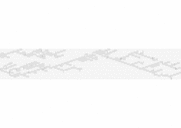Reversible/Quantum Arithmetic
Reversible/Quantum Arithmetic
1 Understanding the Animations and Circuit Diagrams
The circuit diagrams in the table below, in GIF and XFIG formats, are
in relatively standard format for quantum computing. Look first at
the circuit GIF. Each horizontal line is a single qubit, and time
flows left to right. Each vertical line segment is a gate. The small,
dark dots indicate control lines, and the large, open circle is the
target qubit.
If you look at the VBE adder, you can see that in the first time slot,
a bunch of gates are executed concurrently on different qubits, then
in later time slots only one or two are.
Compare this to the animation. At the beginning of the VBE example,
there is a lot of activity, then it dies down and you can see the
carry ripple back and forth across the quantum register. Each sphere
is a (logical) qubit. The motion of the arrows indicates only that a
gate is being performed, nothing about the actual state. The golden
arches are two-qubit and three-qubit gates. Qubits are green when
they have been initialized, but no gates have affected them yet.
Recently used qubits are red; as they "age", they fade toward blue.
This provides visual information about which parts of the qubit
register are idle, and which are active.
Now look at the Aqua source, and you'll see the gates, the CCNOTs
(control-control-NOT) and the CNOTs (control-NOT). In my Aqua
notation, the label at the beginning of a line of source is the time
slot in which the gate is executed, and the time doesn't increment
until you see the next such label.
2 Architectures
The architectures shown here, AC, TC, and NTC, are described on
our taxonomy page and in our paper,
quant-ph/0408006.
3 Adders
In order to design a useful computer, one must understand the behavior
of its most common uses. Arithmetic naturally forms a core element in
any library of functions.
Addition of two n-bit numbers on a neighbor-only architecture is
limited to O(n) when non-neighbor architectures can reach
O(logn), demonstrating that physical characteristics of a
computing device have an important impact on both real-world running
time and asymptotic behavior.
The conditional-sum and carry-select adders are our original designs.
The other adders come from various papers listed on
our recommendations page. VBE is
Vedral-Barenco-Ekert, and BCDP is Beckman-Chari-Devabhaktuni-Preskill.
The carry-lookahead adder, one of the most promising circuits, is by
Draper, Kutin, Rains, and Svore.
| adder algorithm | problem | storage | AC | TC | NTC |
| size | space | | | |
|
| VBE carry ripple | 8 | 24 | | | |
| animation | | |  | coming soon | coming soon |
| GIF | | |  | coming soon | coming soon |
| XFIG | | | vbeadder8.fig | coming soon | coming soon |
| Aqua source | | | vbeadder8.ac | coming soon | coming soon |
|
| BCDP carry ripple | | | | | |
| animation | | | coming soon | coming soon | coming soon |
| GIF | | | coming soon | coming soon | coming soon |
| XFIG | | | coming soon | coming soon | coming soon |
| Aqua source | | | coming soon | coming soon | coming soon |
|
| carry select | 6 | 32 | | | |
| animation | | |  | coming soon |  |
| GIF | | |  | coming soon |  |
| XFIG | | | csel6src.fig | coming soon | csel6bin.fig |
| Aqua source | | | csel6src.ac | coming soon | coming soon |
|
| conditional sum | | | | | |
| animation | | | coming soon | coming soon | coming soon |
| GIF | | | coming soon | coming soon | coming soon |
| XFIG | | | coming soon | coming soon | coming soon |
| Aqua source | | | coming soon | coming soon | coming soon |
|
| carry lookahead | 10 | 35 | | | |
| animation | | |  | coming soon | coming soon |
| GIF | | |  | coming soon | coming soon |
| XFIG | | | lookahead10src.fig | coming soon | coming soon |
| Aqua source | | | lookahead10src.ac | coming soon | coming soon |
Table 1: Adder circuit various architectures
and choices of algorithm. AC, abstract concurrent
architecture. TC, two-qubit gate, concurrent architecture. NTC
neighbor-only, two-qubit gate, concurrent architecture.
4 Fast Quantum Modular Exponentiation
See our full paper, "Fast Quantum Modular Exponentiation", for
numeric results and the detailed circuits. The paper is available on
our publications page.
Abstract:
We have performed a detailed analysis of the impact on modular
exponentiation of architectural features and possible concurrent gate
execution. Various arithmetic algorithms are evaluated for execution
time, potential concurrency, and space tradeoffs. We find that, to
exponentiate an n-bit number, for storage space 100n (twenty times
the minimum 5n), we can execute modular exponentiation one hundred
to seven hundred times faster than optimized versions of the basic
algorithms, depending on architecture, for n=128. Addition on a
neighbor-only architecture is limited to O(n) when non-neighbor
architectures can reach O(logn), demonstrating that physical
characteristics of a computing device have an important impact on both
real-world running time and asymptotic behavior. Our results will
help guide experimental implementations of quantum algorithms and
devices.
5 Additional References
See also the Qwiki page on
quantum
arithmetic for a list of papers on the topic.
rdv@sfc.keio.ac.jp
Copyright 2007 Rod Van Meter
Last modified: $Date: 2007/04/05 02:25:41 $
File translated from
TEX
by
TTH,
version 3.63.
On 5 Apr 2007, 12:28.

